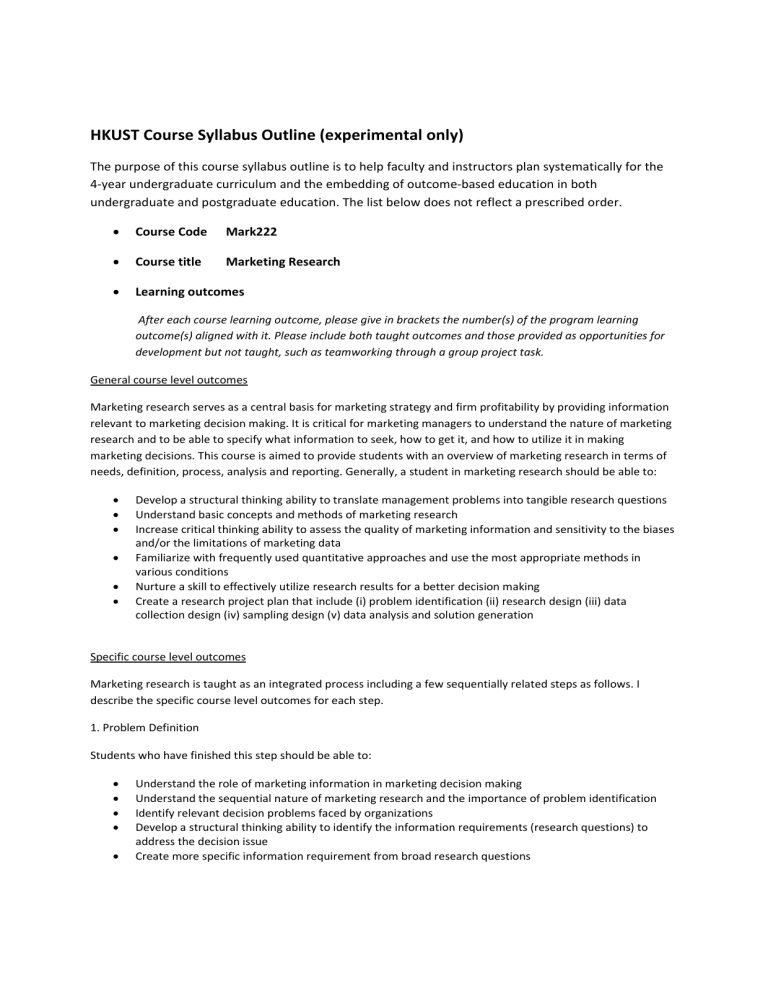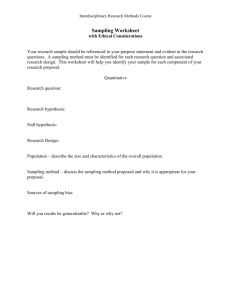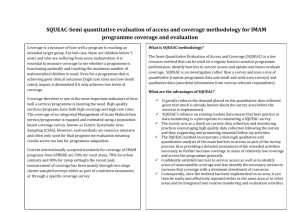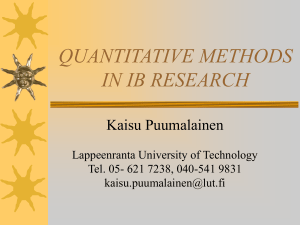HKUST Course Syllabus Outline (experimental only)

HKUST
Course
Syllabus
Outline
(experimental
only)
The purpose of this course syllabus outline is to help faculty and instructors plan systematically for the
4 ‐ year undergraduate curriculum and the embedding of outcome ‐ based education in both undergraduate and postgraduate education.
The list below does not reflect a prescribed order.
•
Course Code Mark222
•
Course title Marketing Research
•
Learning outcomes
After each course learning outcome, please give in brackets the number(s) of the program learning outcome(s) aligned with it.
Please include both taught outcomes and those provided as opportunities for development but not taught, such as teamworking through a group project task.
General course level outcomes
Marketing research serves as a central basis for marketing strategy and firm profitability by providing information relevant to marketing decision making.
It is critical for marketing managers to understand the nature of marketing research and to be able to specify what information to seek, how to get it, and how to utilize it in making marketing decisions.
This course is aimed to provide students with an overview of marketing research in terms of needs, definition, process, analysis and reporting.
Generally, a student in marketing research should be able to:
•
Develop a structural thinking ability to translate management problems into tangible research questions
•
Understand basic concepts and methods of marketing research
•
Increase critical thinking ability to assess the quality of marketing information and sensitivity to the biases and/or the limitations of marketing data
•
Familiarize with frequently used quantitative approaches and use the most appropriate methods in various conditions
• Nurture a skill to effectively utilize research results for a better decision making
•
Create a research project plan that include (i) problem identification (ii) research design (iii) data collection design (iv) sampling design (v) data analysis and solution generation
Specific course level outcomes
Marketing research is taught as an integrated process including a few sequentially related steps as follows.
I describe the specific course level outcomes for each step.
1.
Problem Definition
Students who have finished this step should be able to:
•
Understand the role of marketing information in marketing decision making
•
Understand the sequential nature of marketing research and the importance of problem identification
• Identify relevant decision problems faced by organizations
•
Develop a structural thinking ability to identify the information requirements (research questions) to address the decision issue
• Create more specific information requirement from broad research questions
2.
Research Design
Students who have finished this step should be able to:
•
Understand the importance of research design as a blue print for marketing research projects
•
Understand the difference of three major research design: exploratory research, descriptive research, and causal research
•
Decide which research design should be used for the research questions in hand
•
Conduct the focus group study in order to extract exploratory information for the research issues
• Understand the concept of causality and the concept of controlled experiment
•
Assess the internal validity of an experiment in terms of control and randomization
•
Assess the external validity of an experiment
•
Apply the concept of causality to the issue of test marketing for new products
3.
Data Collection Design
Students who have finished this step should be able to:
•
Understand the nature of primary/secondary data
•
Assess the quality of various types of secondary data including scanner data and utilize them effectively
•
Understand the concept of measurement and measurement scale
•
Assess/critique the validity of measurement (construct validity, reliability, etc)
• Apply the measurement tools to measure attitude by utilizing various measurement scale (semantic differential scale, Likert scale, etc)
•
Create questionnaire to collect information
4.
Sampling Design
Students who have finished this step should be able to:
• Understand the nature of sampling study vs.
population study
•
Identify an appropriate sampling frame for a research project
•
Understand the various sampling method (probability sampling and non ‐ probability sampling)
•
Determine the required sample size and understand the logic behind sample size determination
•
Understand the concept of sampling error and non ‐ sampling error
• Identify the source of possible error and/or bias in a research project
•
Increase sensitivity to bias and single out the possible sources of the systematic errors in a research project or in a marketing data set
5.
Data Analysis
Students who have finished this step should be able to:
•
Understand data coding and generate compute file for quantitative analysis from qualitative questionnaire
•
Conduct various types of univariate analysis such as simple tabulation and descriptive statistics to describe a variable
• Conduct basic bivariate analysis such as Chi ‐ square independence test through cross ‐ tabulation and mean ‐ difference testing using ANOVA to extract information on the relationship between two variables
•
Understand the statistical concept regarding regression
•
Measure economic quanitities such as price elasticities using regression model
• Create perceptual maps using Multidimensional Scaling
•
Design and conduct rating ‐ based conjoint studies
• Utilize compute software such as SAS to implement aforementioned analytical models
6.
Report
Students who have finished this step should be able to:
• Create qualitative decision relevant information from quantitative data analysis output
•
Generate user ‐ friendly and executive ‐ friendly research report
• Make definite suggestions to the decision problem
•
Identify the limitation of the project and the future research opportunities
7.
Ethics
Students who have taken this course should be able to:
•
Understand ethical principles and codes of conduct that must be observed when any research project is conducted.
•
Apply these practices in the conduct of their own market research project
•
Course description
Marketing research serves as a central basis for marketing strategy and firm profitability. Therefore it is critical for a manager to understand marketing research and to be able to specify what needs to be studied, how to study it, and how to interpret the results. This course presents an overview of marketing research in terms of needs, definition, process, analysis and reports. Our approach is practical and mainly quantitative.
By understanding the research discipline, the practice and application should become comfortable and available to you.
Teaching approach
This section outlines the instructional strategy and covers how the learning outcomes, the teaching and learning activities (e.g.
lecture, interactive seminar, labs, case discussion, field ‐ trip, individual or group project, online learning, etc.) and the assessments are aligned with each other
‐ Develop problem analysis skills, and ability to translate a management problem into a feasible research question.
‐ Provide with a working knowledge of basic concepts and methods of marketing research.
‐ Increase sensitivity to the biases and limitations of marketing data.
Familiarize with some of the quantitative approaches to analyze customer characteristics, market segmentation, latent market structures, consumer choices and consumer response behave
Required Textbook: Churchill, Gilbert A.
Jr., Basic Marketing Research , 6 th
Edition, Dryden Press.
•
Assessment scheme
This includes the assessment type (exams, quizzes, written assignmenta, case assignments, presentations, etc), a brief description and the weighting.
In Class Assignment (5):
Exams (2):
Individual Class Participation:
Group Project Presentation:
Group Project Report:
Total:
•
Student learning resources
50
200
100
500 points
50 points
100 points
points point
points
This can include course textbook, course pack/Other Required readings, optional readings (please ensure any Library course support site/course reservations, as well as any URLs, which can be linked in the LMES course website, including Library course pages.
‐ Course textbook
‐ Course pack/Other required readings
‐ Optional readings (please ensure any Library course support site/course reservations, as well as any
URLs, are linked in the LMES course website)
•
Course schedule
Phase 1 : Form Groups (Each group consists of 5 ‐ 6 students from the same session).
• Turn in group member form by Feb.
19.
Phase 2 : Select Topic.
•
Discuss the selection of topics with instructor on Feb.
26 .
• Submit on March 4 a one ‐ page written report specifying your topic, including background, decision and research problems.
Phase 3 : Research Proposal due on March 18 .
•
Tentative project title;
• Decisions involved;
•
Research problems;
•
Method and research design;
•
Estimate of time requirement.
(Cost estimate not required)
•
Page limit: 2 pages (not including cover page).
Phase 4 : Data Collection, Data Coding, and Data Analysis.
Phase 5 : Final Report.
•
Teaching staff contact details
Faculty/instructors and TA(s) where appropriate
Prof Ying Zhao, room 4364, email: mkyzhao, tel:x.7701
Edrie/Florence, room 4371, email: edriecto, flolee, tel:x.7705
•
Academic honesty
Please provide a link to the HKUST Academic Integrity site at http://www.ust.hk/vpaao/integrity/ You may also wish to include your subject/course ‐ specific arrangements for avoiding plagiarism.
Any student who violates academic integrity, through such activities as duplication of another students’ work in whole or in part, plagiarism, etc.
or other means of cheating, will receive an F for the course.
There is no honor in taking someone’s work as your own.
•
Learning environment
In creating this section you may wish to refer to the HKUST good learning experience site at http://www.ust.hk/vpaao/conduct/good_learning_experience.pps/ You may also wish to discuss with your students your expectations of their classroom behavior.
‐ Arriving on time
‐ Arriving quietly, if you must be late
‐ Listening when I am talking
‐ Turning off your mobile phone
‐ Leaving only when the class is finished
‐ Keeping quiet when classmates are trying to listen
‐ Taking classmate’s questions and answers seriously
‐ Making the class a comfortable experience for everyone
Follow ‐ up questions after completing the Course Syllabus Outline
1.
Which of the course learning outcomes stated above already being addressed by the faculty/instructor(s) teaching this course?
2.
Which of the course learning outcomes do you think are not being addressed, or need to be addressed more fully, and what would be your plan of action for addressing any gap(s)?
3.
What support (resources, sharing, training), if any, do you think you need to accomplish the changes in 2 above?










